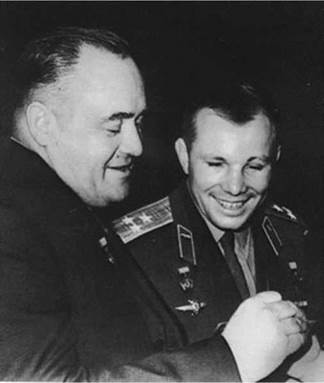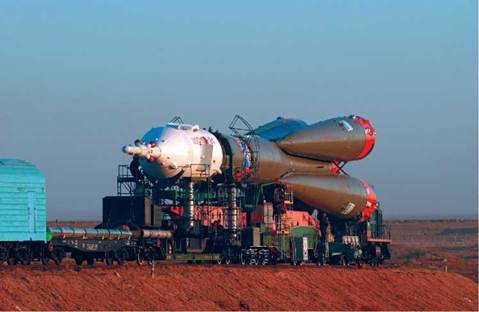HUMAN SPACE FLIGHT OPERATIONS
The first half century of human space operations has, by any measure, been spectacular and rapid. It had taken hundreds of years to progress to this point, where human space exploration was more than just a dream. After mastering the techniques of balloon flight, gliders, and finally powered flight, it took another half a century to devise systems, procedures, and infrastructure to place manmade objects into space. In the half a century since then, we have created a huge space complex based on the experiences of at least nine earlier space stations, explored the Moon, and launched pathfinder probes to the farthest planets in the solar system, pioneering the way for humans to follow at some point in the future. Human endurance on space flight has increased from minutes to months and the number of crew rose from single-seat space flights to successive international
D. J. Shayler and M. D. Shayler, Manned Spaceflight LogII—2006—2012, Springer Praxis Books 158, DOl 10.1007/978-1-4614-4577-7_2, © Springer Science+Business Media New York 2013
|
Sergei Korolev and Yuri Gagarin, heroes of the Soviet Space Program. |
expeditions of up to six on the ISS. The station itself has operated with a crew continuously, 24/7 and 365 days a year, for over a decade.
Plans for large space complexes, bases on the Moon and colonies on Mars, the exploitation of asteroid minerals, and planetary journeys have been suggested for decades. They will surely occur, perhaps not in our lifetime, but not so far in the future to think that it is totally impossible from the standpoint of current technology. Interstellar travel may remain within the realms of science fiction for some considerable time to come, but who knows for sure?
It has taken humans thousands of years to expand across our planet and develop the knowledge, skills, and experience to “live” here, and we are still learning and exploring. It took over 300 years to explore the Pacific Ocean and its environs and we are still investigating the deep jungles, high mountains, and frozen polar caps. We have only touched upon the vast expanses of the ocean beds. All of this could be classed as planetary exploration, but of the planet we all live on. With all this covering such a passage of time in the history of human exploration of Earth, why should we expect so much, so quickly from our explorations in space after only half a century?
Launch systems
Active participation in a flight into space starts, logically, with the flight. This is a short, 8-10-minute, exciting, explosive, but always interesting, trip from the launchpad to low Earth orbit. Getting off the planet is always the first hurdle and, as the German rocket engineer Werner von Braun once explained, “Once you have left Earth, you are halfway to anywhere.”
For the first journeys into space, adapted ballistic missiles were used to carry a human crew, riding on Vostok, Voskhod, Mercury, and Gemini spacecraft. For Apollo, a new family of “space boosters” was developed—the Saturn rockets— which were powerful enough to take the first men to the Moon and to launch America’s only space station. Unfortunately, the rocket developed for the Soviet manned lunar program did not perform as planned and cosmonauts never rode the goliath off the pad. It was the smaller, ballistic missile, designated the R-7, which became the workhorse for the Soviet and subsequent Russian space program. More recently, it has also given international crew members access to space when the Shuttle was unavailable and following its retirement in 2011.
For over 50 years, the R-7 in its various guises has propelled cosmonauts from the national launch site in Baikonur to orbit on over 100 missions. The reliability and ruggedness of the design and the foresight of the decision to go with the launch vehicle in the 1950s are remarkable. Despite all the international technology, advanced designs, and countless proposals and plans, the most reliable
|
A Soyuz is rolled out to the launchpad on a rail transporter. |
and long-lasting launch system to Earth orbit is one that has been around for as long as we have ventured into space. In 50 years, it has endured very few launch – pad aborts and only two launch incidents; the 1975 third-stage separation failure and 1983 pad abort both resulted in the safe recovery of the crew. It stands as a remarkable credit to Russian engineering that it is this R-7 which has outlasted all the other launch vehicles that have taken humans into space.
With the retirement of the Shuttle, there remain (2012) only two operational manned (orbital) space flight launch systems available in the global program, the Russian R-7 and the Chinese Long March 2F. There are plans and designs in development for carrying human crews on board, but these are still some years away from operational use.
The Mercury-Redstone, Mercury-Atlas, Gemini-Titan II, Apollo-Saturn IB and Saturn V were very successful, with no launch failures and very few “near misses” considering the pioneering nature of their use in the early years of manned space flight. Over the 135 launches of the Space Shuttle system, there was only one tragic launch accident (Challenger) resulting in the loss of life and one launch abort to orbit (STS-51F). Though termed operational from its fifth launch, the Shuttle system in hindsight could only be termed a research vehicle rather than totally “operational” in the true sense of the word, due to the changes in launch manifests and delays in ground processing. Indeed, it would be difficult to term any manned launch system, apart from perhaps the R-7, as operational, due to the length of time in service and the number of launches completed.












